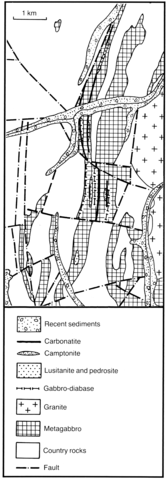stripes
Dykes and veins of alkali gabbro, lusitanite, pedrosite, camptonite, solvsbergite and carbonatite occupy a zone 1.5 km wide and more than 18 km in length. The lusitanite dykes are up to 200 m thick and 2 km long and fenitize the surrounding rocks. They consist of 60-95% magnesioriebeckite, up to 25% alkali feldspar, aegirine, biotite and apatite. Accessories include pyrochlore, columbite, magnetite, ilmenite, titanite and chalcopyrite, with secondary quartz and calcite also present. The pedrosites are essentially magnesioriebeckite (95-99%) rocks which form vein-like bodies up to 2 m wide within lusitanites. The solvsbergites are porphyritic aegirine-feldspar rocks with phenocrysts up to 1.5 cm diameter of aegirine, occupying about 25% of the rock, and albite; the aegirine has inclusions of magnesioriebeckite, albite and microcline. Carbonatite forms dykes up to 200 m wide and 3 km in length. They are compositionally variable with calcite, dolomite-calcite and ankerite-calcite carbonatites represented. The calcite carbonatites consist of up to 95% calcite as crystals up to 10 cm diameter, needles of magnesioriebeckite (5%) up to 4 cm in length, apatite (2%) and iron oxides. The dolomite-calcite carbonatite consists of 40-85% calcite, 10-55% dolomite, 5-7% amphibole, apatite and iron oxides. Among the ankerite-calcite carbonatites are lenses, up to 2 m across, enriched in pyrochlore (15-35%). There is in places enrichment of the carbonatites in sulphides (up to 15-20%) including pyrrhotite, pyrite and chalcopyrite.
*ZABRODIN, V.Yu. and MALYSHEV, A.A. 1975. New alkalic ultramafic and carbonatite complex on the Yenisei Ridge. Doklady Earth Science Sections, American Geological Institute, 223: 195-8.
*ZABRODIN, V.Yu. and MALYSHEV, A.A. 1978. A new association of basic-alkaline rocks and carbonatites on the Yenisey ridge. International Geology Review, 20: 517-24.

